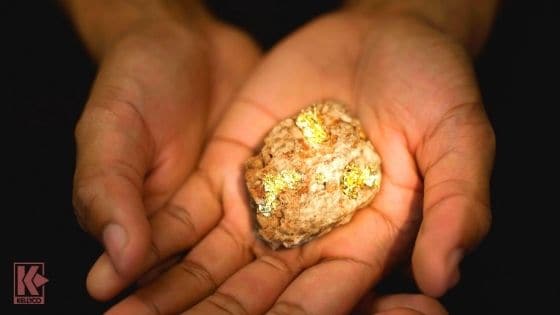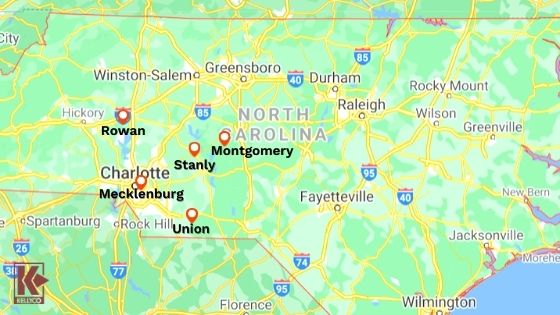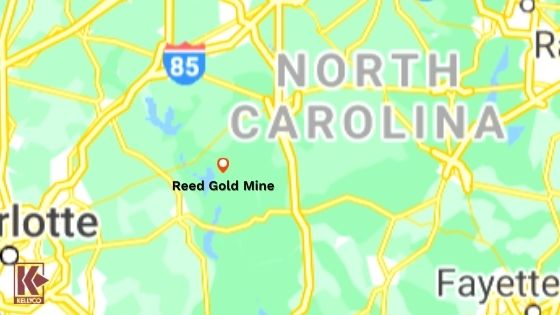The Carolina Gold Rush: North America’s First Significant Gold Rush
Published by Sam Jacobs on 09/22/20

Gold Prospecting
You probably don’t think of North Carolina as a hotbed of gold mining, despite the mascot of the University of North Carolina being a gold prospector. In fact, those unfamiliar with the history of the region might be confused as to why UNC chose this, of all things, as their mascot. However, once upon a time, it was the second biggest industry in the Tarheel State after agriculture which led to what is known as The Carolina Gold Rush. And it all began with a 12-year-old boy happening upon a gold nugget in Cabarrus County, 50 years before anyone dreamed of finding any gold in the “Golden State.”
Conrad Reed was out playing on Meadow Creek in Cabarrus County (northeast of modern-day Charlotte and in the southern central part of the state), which ran through his family’s farm when he found a 17-pound gold nugget. No one thought there was gold in the area, so no one in his family thought anything of the treasure the boy brought home. The rock was wedge-shaped and approximately the same size as a flatiron. They thought it was an interesting curiosity, but little else, and the find was used as a doorstop for several years in the Reed home.
Three years later, Reed’s father showed the “doorstop” to a jeweler who immediately recognized it for what it was and offered to purchase it. Reed decided to sell it, for the princely sum of $3.50 ($62.54 in 2019 dollars), which was the average weekly wage for a farm laborer at that time. The actual value of the nugget was somewhere in the neighborhood of $3,600 at the time, but the current market price of a 17-pound gold nugget is over a quarter-million dollars. They had previously brought the “doorstop” to a silversmith who, unfortunately for the Reeds, was unable to identify the raw gold.
For what it’s worth, Reed didn’t seem to have any concept of what the gold was worth. It was Reed who suggested $3.50 as the price, which seemed like a large sum of money to him. He did quickly learn about the mistake he had made and the jewelry paid him an additional $1000. After this, the search for more gold on the land began in earnest. They mostly looked during the summer, not just because they weren’t working on tilling the fields, but also because the creek was much drier, which made hunting for gold a more fruitful enterprise.
Reed eventually learned about the true value of what he had sold and entered into a partnership to extract the massive value from his land. Regional newspapers spread the news of the find and soon everyone was trying to get in on the bonanza. However, the Carolina Gold Rush was different from later gold rushes in that it wasn’t a free-for-all that anyone could get in on. Rather, the Carolina Gold Rush was primarily about small farmers investing in their own land to extract the riches that lay below the surface. It was also mostly a side project for the farmers who would go out hunting for gold after the growing season was over.
The North Carolina Gold Rush Begins in Earnest

The North Carolina Gold Rush
Gold was soon found in the surrounding counties of Mecklenburg, Montgomery, Rowan, Stanly, and Union. People poured into the region hoping to get a piece of land that would have the next big paying gold mine. One of these people was William Thornton, better known as the man who designed the United States Capitol building. He purchased 35,000 acres of land in the region forming the North Carolina Gold Mine Company whose investors included the former Governor of Maryland and a former Treasurer of the United States.
Prior to that, there were very few people in the region and it was primarily an underdeveloped backwater. There were fewer than 100 families in the region, primarily of Scots-Irish stock, but also some Germans. They were all farmers raising livestock and some foodstuffs.
The farmers were able to do this using a technique known as placer mining. This is where a stream is mined for gold in the manner of “panning for gold” using a variety of tools and technologies that were contemporary at the time. Panning for gold doesn’t have the efficiency of more modern techniques, but it was all that farmers were able to do and it served their purposes well enough. The gold extracted through this method is also low-hanging fruit, so by the 1820s, all the deposits that were able to be extracted through placer mining were exhausted. This led to the opening of the first lode mine shaft in 1825. There were also significant changes in mining technology around this time that allowed for a greater yield but largely meant that farmers could no longer perform the mining operations.
Cornwall Miners Leave Their Mark on North Carolina
The need for skilled miners meant that there was an influx of immigrants from England, primarily from the ceremonial county of Cornwall in the far southwest of England. The spread of news about the big gold strike was not limited to North Carolina or even the United States — it had spread to Europe as well. Copper mining and tin mining were the major projects there but by the early 19th Century there was no more copper and tin to be mined in the region, so those miners were looking for work around the same time that the Carolina Gold Rush started taking off. In addition to how they changed the population of the region, the influence of Cornish miners can be seen in the design of the ore mills, which are nearly identical to the ones in Cornwall.
They also taught their techniques to the local miners. The techniques that came from Cornwall spread throughout the entire Carolina terrane where they quickly became standard operating procedures in all mining in the region. This labor pool later is what made it possible for the California Gold Rush to happen. The labor supply was there to get gold out of the mines in an efficient way when Americans started finding gold out west. Unsurprisingly, it was typically single men who set out west to find their fortune while the married miners were content to stay in the Carolina region that had previously been so good to them.
The Carolina Gold Rush was largely put to bed by the fact that it wasn’t a free-for-all and because gold was discovered in Georgia in 1828. The locus of American gold fever thus moved a few hundred miles south, but the region where the Carolina Gold Rush first took place continued to be a powerhouse in terms of gold production in the United States.
Whatever Happened to John Reed?

Reed Gold Mine
John Reed, Conrad’s father, of course, had his own mining operation, known as the Reed Gold Mine. He started with placer mining and a slave named Peter soon found a 28-pound gold nugget, the market value today of which would be closer to a million dollars than not. Underground mining began on the site in 1831.
John Reed was originally Johannes Reith, an illiterate Hessian soldier who saw action during the American Revolution underneath Colonel Friedrich von Purbeck. He later deserted the British with his arms and equipment somewhere outside of what is now Savannah, Georgia. He settled first in the lower part of North Carolina and later upper Mecklenburg County. He finally landed in Cabarrus County, where an ethnic German enclave had come together. This is where he anglicized his name and also where he struck gold.
Reed died a wealthy man thanks to the mine. Still, he lived a modest life, largely investing the money that he made back in the land and in the slaves to work it. He purchased an additional 2,000 acres of land in the area, retaining about half of it and flipping the other half. At a time when the average North Carolinian owned no slaves, Reed and his partners joined the upper crust of society by being part of the top 2 percent of all slave owners in the state.
Other North Carolina Farmers Get in on the Action
Many of the landowners never profited from gold strikes at all but were able to make a handsome return on their land by selling it to speculators hoping for the next big motherlode of gold. Some kept the land, selling only the mineral rights to the land, which was a very low risk — they could continue to till the land while speculators took all of the risks for gold that might or might not even be there.
The first lode was found in Stanly County on the land of a man named Tobias Barringer. Union County’s Smart Mine (which was operational from 1835 to 1911) and the Howie Mine (which ran from 1840 to 1942). The Carolina Gold Rush peaked in the 1830s and 1840s when there were fully 56 mines operating in the state. Entire towns sprung up to support the workforce, which had ballooned to 25,000, as well as the industry related to extracting purer forms of gold from the raw ore. Up until 1829, North Carolina was the only state that was producing domestic gold for the purpose of minting coins for the United States.
Mining activity at the Reed Gold Mine decreased significantly during the American Civil War. The Confederacy badly needed both labor and resources and the Reed Gold Mine was taking too much of the former without providing enough of the latter to justify it continuing to be open. The last significant find through placer mining took place in 1896. Underground mining was discontinued on the site in 1912. But during the late 19th Century and until the mine was shuttered, it was one of the biggest producers of gold for the American treasury. The Charlotte Mint largely existed to process the gold from the Reed Mine and other mines like it in the area of the original Carolina Gold Rush. However, there was gold mined in North Carolina all the way up until 1971, the value of which is somewhere in the neighborhood of $25 million. Most of this, however, was mined before 1900. When the preliminary excavations were being performed for the One First Union Center in 1988 and the NationsBank Corporate Center in 1992, trace amounts of gold were found, attesting to the incredible value of the gold in this region.
North Carolina Gold Mining Today

Gold Mining
These days anyone can go to the Reed Gold Mine. It’s a National Historic Site owned and operated by the North Carolina Department of Natural and Cultural Resources. There is a museum dedicated to the history of mining in North Carolina. Visitors can also go inside the gold mines, which have been reconstructed for visitation by the general public.
There is still a little bit of gold mining taking place in the state, but nothing compared to the glory days of the Carolina Gold Rush. Most of the hunt for gold today is about finding ways to extract it from volcanic rock. There are no active mines as such, but some people are still doing a little placer mining in the region, hoping to find a nugget or two that the Carolina Gold Rush and the resulting intensive mining in the region might have missed. All that said, it is estimated that only 2 percent of the gold in the region has actually been mined.
One of the most important lessons to learn for people who have never heard of the North Carolina Gold Rush is that there is gold to be found in a number of areas that are not necessarily thought of as being “gold-rich.” Indeed, one never knows where the might be gold, even underneath your land. But whatever you do, don’t sell your gold doorstop for a couple of hundred dollars, even if it is simply the first sign that you’re sitting on top of a total bonanza.
